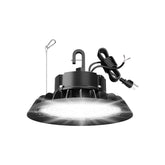Explore constant current drive and constant voltage drive
Lighting Driver Working principle
-
Constant current drive: It can ensure that the output current remains constant when the load (such as LED beads) changes. Its principle is based on feedback control. By detecting the output current and comparing it with the set value, the circuit parameters are automatically adjusted to stabilize the current at the set level. Even if the forward voltage of the LED fluctuates due to factors such as temperature and batch, the constant current driver can still maintain a constant current.
- Constant voltage drive: Its main function is to maintain a constant output voltage. Regardless of how the load changes, the driver will automatically adjust the working state of the internal components to ensure that the output voltage remains stable at the preset value. However, the output current will change with the variation of the load resistance, following Ohm's Law (I = U/R).
Performance characteristics
Brightness stability
-
Constant current drive: Due to the constant current, the luminous brightness of the LED can remain consistent and is not affected by forward voltage fluctuations. Even during long-term use or when the ambient temperature changes, the brightness can remain stable, effectively avoiding flickering or variations in brightness and providing a stable lighting effect.
- Constant voltage drive: When the resistance of the load (LED beads) changes, the output current will change accordingly, thereby causing unstable LED brightness. For example, as the temperature of the LED rises, its resistance decreases, the current increases, and the brightness also becomes higher. Conversely, the brightness will decrease.

Efficiency
-
Constant current drive: Under the matched load conditions, it can efficiently convert the input electrical energy into light energy, and the efficiency is usually relatively high. However, if the load does not match, it may lead to the loss of some energy in the form of heat, affecting the overall efficiency.
- Constant voltage drive: The circuit structure is relatively simple, and in some cases, the energy conversion efficiency is also relatively high. However, when multiple leds are used in parallel, due to the difference in the forward voltage of each LED, it may lead to uneven current distribution, thereby reducing the overall efficiency.
Reliability
-
Constant current drive: It can provide a stable current for leds, prevent damage to leds due to excessive current, extend the service life of leds, and improve the reliability of the system. It is especially suitable for occasions where high requirements are placed on the lifespan and stability of leds.
- Constant voltage drive: As the current varies with the load, when a certain LED malfunctions (such as short circuit or open circuit), it may affect the working state of other leds, and even cause abnormal current distribution in the entire circuit, reducing the reliability of the system.
Applicable scenarios
- Constant current drive: It is suitable for occasions with high requirements for brightness consistency and stability, such as commercial lighting (shopping malls, exhibition halls, etc.), stage lighting, automotive lighting, etc. In these scenes, stable brightness is crucial for creating a good visual effect. In addition, for high-power LED lighting, constant current driving can better protect the LED chips and ensure their safe and stable operation.
- Constant voltage drive: It is often used in situations where the brightness requirement is relatively low, cost is sensitive, and the load is relatively stable, such as ordinary indoor decorative lighting (LED light strips, small wall lamps, etc.). These scenarios do not have high requirements for the consistency of brightness. The simple structure of constant voltage drive and its relatively low cost make it a suitable choice.
-
Constant current drive: Due to its complex circuit design, it requires precise current control and feedback mechanisms, thus the manufacturing cost is relatively high. In addition, constant current drivers usually require higher-quality components to ensure the stability of the current, further increasing the cost.
- Constant voltage drive: The circuit structure is simple, fewer components are used, and the cost is relatively low. This makes constant pressure drive have obvious advantages in some applications that are more sensitive to cost.
Balises :









